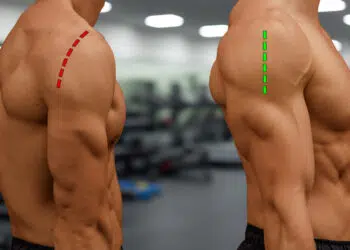The late Louie Simmons of the Westside Barbell fame invented the reverse hyperextension machine to help athletes build a robust posterior chain without axially loading the spine. This, combined with his conjugate training method, enabled athletes to squat, bench, and deadlift ungodly amounts of weight.
A study published in the Journal of Strength and Conditioning Research found that reverse hyperextensions (RHE) generated significantly greater peak, integrated, and mean low back movement compared to conventional hyperextensions (HE). It also resulted in a greater thigh-to-trunk ROM, with less lumbar flexion, suggesting that RHE could be preferable for achieving greater hip ROM with less stress and equivalent erector spinae activity. (1)
That said, the reverse hyperextension machine is a specialized training equipment that is not available in every gym.
I have compiled a list of 12 reverse hyperextension alternatives I use with my personal training clients to get similar results and fortify the posterior chain.
12 Top Reverse Hyperextensions Alternatives
Use the following reverse hyperextension alternatives to bolster the posterior chain:
GHD Reverse Hyperextensions
Thanks to CrossFit’s popularity, the GHD machine has become common in gyms around the world. The GHD reverse hyperextension is among the closest reverse hyperextension alternatives that you can perform.
Level Up Your Fitness: Join our 💪 strong community in Fitness Volt Newsletter. Get daily inspiration, expert-backed workouts, nutrition tips, the latest in strength sports, and the support you need to reach your goals. Subscribe for free!
You must adjust the GHD bench at an appropriate height to ensure a full range of motion and bias the erector spinae, glutes, and hamstrings. The curved hip pads of the GHD machine help you achieve greater depth on eccentrics comfortably.
How To:
- Adjust the GHD machine so the hip pad and footrests are at the same level, and your hips are clear off the pads.
- Lie on the pads and place your hip crease on the edge of the pads. Grab the lower foot pads with an overhand grip.
- Keep your spine neutral and your lower body perpendicular to the floor at the starting position.
- Squeeze your glutes, hamstrings, and lower back to raise your legs toward the ceiling.
- Your body should be in a straight line and parallel to the floor at the top of the ROM.
- Hold the isometric contraction for a couple of seconds.
- Slowly return to the starting position.
Pro Tip: Advanced exercisers can wrap one end of a loop resistance band around the base of the GHD machine and the other around their ankles for added resistance. I have my clients fight the resistance on the eccentrics for maximal target muscle stimulation.
Bench Reverse Hyperextensions
Even if you don’t have a GHD machine, you can still perform the reverse hyperextensions. All you need is a flat bench. However, taller athletes may need to place the flat bench on a few aerobic steppers at each end to ensure optimal elevation for a full ROM.
How To:
- Lie prone on a flat bench with your hip crease at the bench’s edge.
- Extend your hands overhead and wrap your fingers around the bench’s other edge.
- Flex your knees and hips so your upper legs are perpendicular to the floor while the lower are parallel.
- Hold your feet hip-width apart for maximal lower body stimulus.
- Contract your glute and hamstring and simultaneously extend your hips and knees.
- Your body should be in a straight line at the top of the range of motion.
Pro Tip: I have my personal training clients wear a fabric resistance band around the bottom of the upper legs for a deeper target muscle contraction. Furthermore, performing this exercise on an incline bench can make it more challenging. Set the incline between 30 to 45 degrees; anything over this can remove tension from the glutes and hamstrings.
GHD Raises
GHD raises are a staple in most CrossFit training regimens, and for good reason. This exercise loads the erector spinae, glutes, and hamstrings without axially loading the spine.
While performing the bodyweight variation of this exercise, aim to train to muscle failure. On the other hand, you could wear a weighted vest or hold a weight plate against your chest and perform this exercise in the 8-12 rep range to bias hypertrophy. (2)
How To:
- Set the GHD machine, so your knees are at the edge of the thigh pads.
- Mount the machine and insert your ankles in the foot pads.
- Your shins should be parallel to the floor, and your thighs and torso should be perpendicular to it at the starting position.
- Hold your arms against your chest.
- Slowly extend your knees to lower your torso until it is parallel to the floor.
- Squeeze your glutes and hamstrings to return to the starting position.
- Repeat for recommended reps.
Pro Tip: Use a slow, controlled, and deliberate rep cadence to maximize target muscle activation. Fast eccentrics and concentrics can remove tension from the glutes and hamstrings and place it on the secondary muscles.
Looking for a GHD machine for your home gym? Check out our top picks here!
Kettlebell Swings
I believe kettlebell swings are among the most effective reverse hyperextension alternatives and are also the most neglected. This exercise helps build explosive lower body strength, which can translate to better performance in other compound movements.
Beginners must focus on drilling the movement over lifting heavier weights. As a personal trainer, I see so many people perform this exercise with an incorrect form, leading to suboptimal target muscle stimulation and gains.
How To:
- Stand upright with a wider-than-shoulder-width stance while holding a kettlebell with both hands between your legs.
- While maintaining fully extended elbows, flex your knees, drive your hips back, and thread the kettlebell between your legs until your torso is almost at 45 degrees.
- Explosively extend your hips and knees and thrust your hips into your arms.
- Use the momentum to lift the kettlebell to shoulder level while keeping your elbows extended.
- Use a consistent rep tempo to complete the recommended number of repetitions.
Pro Tip: Remember, you shouldn’t rely solely on your shoulders to lift the kettlebell to shoulder level. Use the hip drive for the initial push-off.
Explore our in-depth kettlebell swing guide here!
Swiss Ball Hamstring Curl
The Swiss ball hamstring curl requires a decent amount of core strength and stability to perform with a full range of motion. Also, use a stability ball that is just the right size so it doesn’t restrict your ROM.
How To:
- Lie supine on the floor with your legs extended and arms at your sides. Place your palms on the floor for greater stability and balance.
- Position a stability ball under the bottom of your lower legs.
- Drive your heels into the stability ball and raise your hips off the floor so your body is in a straight line. This will be the starting position.
- Brace your core and flex your knees to pull the exercise ball toward your bum.
- Your feet should be flat on the stability ball at the peak of the ROM. Squeeze your hamstrings and glutes in this position.
- Slowly extend your knees and hips to return to the starting position.
Pro Tip: I see so many people rush through the reps while performing this exercise. To bias hypertrophy, you must keep the reps slow and controlled and focus on contracting the target muscles for a muscle-ripping pump. (3)
Single-Leg Deadlifts
Unilateral exercises are incredibly effective for fixing strength and muscle imbalances. Single-leg deadlifts must be a part of your reverse hyperextension alternatives arsenal, as they also engage your core stabilizers, which can boost your overall functionality.
How To:
- Grab a dumbbell in each hand and stand upright.
- Lift your left foot off the floor and slightly flex your knee to hold the foot behind the midline.
- Slowly lower your torso toward the floor by hinging at the hips. Lower the dumbbell as close to the floor as possible.
- Pause at the bottom for a deep hamstring, glute, and erector spinae stretch.
- Explode back to the starting position.
- Repeat for recommended reps before switching sides.
Pro Tip: I have my beginner personal training clients perform this exercise while holding a dumbbell in one hand and a sturdy object like a cable pulley machine with the other for better stability.
Maintain a neutral spine throughout the range of motion. Rounding your back on eccentrics and overextending at the isometric contracting can transfer the tension to the secondary muscles.
Next Read: Single-Leg Deadlift Exercise Guide
Level Up Your Fitness: Join our 💪 strong community in Fitness Volt Newsletter. Get daily inspiration, expert-backed workouts, nutrition tips, the latest in strength sports, and the support you need to reach your goals. Subscribe for free!
Nordic Hamstring Curls
The Nordic hamstring curls are among the most brutal reverse hyperextension alternatives. Although these might look super easy, they will smoke your hammies in the very first set.
To be honest, even I couldn’t perform Nordic curls with a strict form on the first try. So, there is no shame in using a little assistance until you can do this exercise with a textbook form.
How To:
- Kneel on a Nordic hamstring curl bench and position your ankles under the bench’s ankle pads.
- Your thighs and torso should be perpendicular to the floor at the starting position.
- Cross your arms against your chest.
- Slowly lower your torso toward the floor by extending your knees.
- Contract your glutes and hamstrings to control the descent.
- Break the fall with your hands when your chest is a few inches off the floor.
- Squeeze your glutes and hamstrings to return to the starting position.
Pro Tip: Avoid hinging at the hips during the eccentrics, as it limits the range of motion and removes tension from the glutes and hamstrings. Beginners can use a little hinge until they can perform this exercise unassisted.
Learn all you need to know about Nordic Ham Curls here!
Box Reverse Hyperextension
The box reverse hyperextension is a hybrid of reverse GHD and bench hyperextension. What I like about this exercise is that you can use multiple plyo boxes to create an appropriate height that allows you to keep your knees extended throughout the ROM.
Furthermore, it limits the range of motion at the bottom, which helps beginners drill the reverse hyperextension movement mechanics.
How To:
- Use a box of an appropriate height so your hips are flexed at 90 degrees and your lower body is fully extended and perpendicular to the floor at the starting position.
- Position your hip crease at the box’s edge and wrap your fingers around the other edge.
- Squeeze your glutes and hamstrings and raise your legs toward the ceiling until they are parallel to the floor.
- Hold the isometric contraction for two seconds.
- Slowly lower your legs to the starting position.
Pro Tip: As a cue, I instruct my clients to avoid banging their toes into the box during eccentrics. You should gently tap the box at the bottom and quickly return to the fully shortened position. Experienced exercisers can hold a medicine ball between their feet for greater adductor stimulation.
Good Mornings
Good mornings are a staple in my training routine to fry the hamstring and glutes. Although they load the spine axially, using proper form and an appropriate weight can help avoid unnecessary back strain.
People training in a commercial gym can also use a hack squat or power squat machine for this exercise.
How To:
- Stand upright with a shoulder-wide stance with a barbell resting across your shoulders.
- While maintaining a slight knee flexion, hinge at the hips and lower your torso until it is almost parallel to the floor.
- Drive your hips backward on eccentrics for greater lower body stimulus.
- Pause in the fully stretched position.
- Reverse the motion to return to the starting position.
Pro Tip: Keep your spine neutral throughout the exercise. Use a 5-1-1-1 rep tempo, which includes spending five seconds on eccentrics and one second each at the bottom, on concentrics, and at the isometric contraction.
Explore our detailed Good Mornings exercise guide!
Hip Thrusts
Barbell hip thrusts are an isolation exercise that loads the glutes and hamstrings without straining the spine. Beginner lifters should substitute the barbell with a dumbbell as it makes it easier to get into position and control during the exercise.
How To:
- Sit on the floor with your back against an elevated object like a flat bench or plyo box.
- Position a barbell across your hip crease.
- Plant your feet flat on the floor shoulder-width apart.
- Drive your hips toward the ceiling until your body, from head to knees, is in a straight line. Your lower legs should be perpendicular to the floor in this position.
- Hold the isometric contraction for a couple of seconds.
- Slowly return to the starting position, but don’t let the weights touch the floor. This ensures constant tension on the target muscles.
Pro Tip: Keep your spine, neck, and head neutral throughout the exercise. Use a barbell pad to prevent the bar from digging into your hips.
Master the barbell hip thrust with this guide!
Superman
The Superman is among the best isometric reverse hyperextension alternatives. This exercise is great for people who train at home and don’t have access to specialized training equipment.
How To:
- Lie prone on the floor with your legs extended.
- Extend your arms overhead.
- Brace your core and squeeze your glutes to lift your lower body and chest off the floor.
- Try pointing your feet and hands toward the ceiling.
- Hold the isometric contraction for as long as possible.
- Repeat for the recommended number of sets.
Pro Tip: Experienced trainers can make this exercise more challenging by wearing ankle weights and grabbing onto 2-pound dumbbells in each hand. Conversely, you could try holding the isometric contraction for 60-120 seconds.
Get a detailed breakdown of the Superman exercise here!
Romanian Deadlift
RDLs are one of the best compound movements to train the entire posterior chain. The limited ROM of this deadlift variation helps bias the hamstring, glutes, and erector spinae.
I like to use dumbbells for this exercise because they allow a more natural wrist position, enabling a more extended range of motion and deeper stretch and contraction.
How To:
- Stand upright with a hip-width stance.
- Grab a dumbbell in each hand with an overhand grip and hold them against your thighs.
- Hinge at the hips, slightly flex your knees and push your glutes backward to lower the dumbbells toward the floor.
- The dumbbells should at least be near the middle of the shins at the bottom. Pause in this position for a deep target muscle stretch.
- Extend your hips and knees to return to the starting position.
Pro Tip: Keep your scapula retracted throughout the range of motion to limit upper back engagement. Focus on pushing your hips back on eccentrics to load the hamstrings and glutes optimally.
Learn the intricacies of RDLs here!
Conclusion
Most people find training the posterior chain more challenging than training their front side. Use the 12 reverse hyperextension alternatives and employ the training techniques explained in this article to build hamstrings, glutes, and erector spinae muscles that would put a pro bodybuilder to shame.
If you have any questions about any of these reverse hyperextension alternatives, drop them in the comments below, and I’d love to help!
References
- Lawrence, M. A., Chin, A., & Swanson, B. T. (2019). Biomechanical Comparison of the Reverse Hyperextension Machine and the Hyperextension Exercise. Journal of strength and conditioning research, 33(8), 2053–2056. https://doi.org/10.1519/JSC.0000000000003146
- Schoenfeld BJ, Grgic J, Van Every DW, Plotkin DL. Loading Recommendations for Muscle Strength, Hypertrophy, and Local Endurance: A Re-Examination of the Repetition Continuum. Sports (Basel). 2021;9(2):32. Published 2021 Feb 22. doi:10.3390/sports9020032
- Hirono, T., Ikezoe, T., Taniguchi, M., Tanaka, H., Saeki, J., Yagi, M., Umehara, J., & Ichihashi, N. (2022). Relationship Between Muscle Swelling and Hypertrophy Induced by Resistance Training. Journal of strength and conditioning research, 36(2), 359–364. https://doi.org/10.1519/JSC.0000000000003478
Interested in measuring your progress? Check out our strength standards for Good Morning, Hack Squat, Deadlift, and more.








